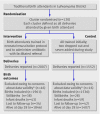Effect of training traditional birth attendants on neonatal mortality (Lufwanyama Neonatal Survival Project): randomised controlled study
- PMID: 21292711
- PMCID: PMC3032994
- DOI: 10.1136/bmj.d346
Effect of training traditional birth attendants on neonatal mortality (Lufwanyama Neonatal Survival Project): randomised controlled study
Abstract
Objective: To determine whether training traditional birth attendants to manage several common perinatal conditions could reduce neonatal mortality in the setting of a resource poor country with limited access to healthcare.
Design: Prospective, cluster randomised and controlled effectiveness study.
Setting: Lufwanyama, an agrarian, poorly developed district located in the Copperbelt province, Zambia. All births carried out by study birth attendants occurred at mothers' homes, in rural village settings.
Participants: 127 traditional birth attendants and mothers and their newborns (3559 infants delivered regardless of vital status) from Lufwanyama district.
Interventions: Using an unblinded design, birth attendants were cluster randomised to intervention or control groups. The intervention had two components: training in a modified version of the neonatal resuscitation protocol, and single dose amoxicillin coupled with facilitated referral of infants to a health centre. Control birth attendants continued their existing standard of care (basic obstetric skills and use of clean delivery kits).
Main outcome measures: The primary outcome was the proportion of liveborn infants who died by day 28 after birth, with rate ratios statistically adjusted for clustering. Secondary outcomes were mortality at different time points; and comparison of causes of death based on verbal autopsy data.
Results: Among 3497 deliveries with reliable information, mortality at day 28 after birth was 45% lower among liveborn infants delivered by intervention birth attendants than control birth attendants (rate ratio 0.55, 95% confidence interval 0.33 to 0.90). The greatest reductions in mortality were in the first 24 hours after birth: 7.8 deaths per 1000 live births for infants delivered by intervention birth attendants compared with 19.9 per 1000 for infants delivered by control birth attendants (0.40, 0.19 to 0.83). Deaths due to birth asphyxia were reduced by 63% among infants delivered by intervention birth attendants (0.37, 0.17 to 0.81) and by 81% within the first two days after birth (0.19, 0.07 to 0.52). Stillbirths and deaths from serious infection occurred at similar rates in both groups.
Conclusions: Training traditional birth attendants to manage common perinatal conditions significantly reduced neonatal mortality in a rural African setting. This approach has high potential to be applied to similar settings with dispersed rural populations. Trial registration Clinicaltrials.gov NCT00518856.
Conflict of interest statement
Competing interests: All authors have completed the Unified Competing Interest form at
Figures
Comment in
-
Training birth attendants in rural Zambia in neonatal resuscitation, and the use of amoxicillin coupled with facilitated referral, reduces neonatal mortality.Evid Based Med. 2011 Oct;16(5):154-5. doi: 10.1136/ebm1402. Epub 2011 May 10. Evid Based Med. 2011. PMID: 21561931 No abstract available.
-
Can traditional birth attendants be trained to reduce neonatal mortality rate? Lessons from Lufwanyama Neonatal Survival Project.Natl Med J India. 2011 Jul-Aug;24(4):220-2. Natl Med J India. 2011. PMID: 22208141 No abstract available.
References
-
- World Health Organization. WHO 2001 estimates: state of the world’s newborns. Save the Children Federation, 2001:1-49.
-
- Black RE, Cousens S, Johnson HL, Lawn JE, Rudan I, Bassani DG, et al. Global, regional, and national causes of child mortality in 2008: a systematic analysis. Lancet 2010;375:1969-87. - PubMed
-
- Lawn JE, Cousens S, Zupan J. Four million neonatal deaths. When? Where? Why? Lancet 2005;365:891-900. - PubMed
-
- American Academy of Pediatrics and American Heart Association. Textbook on neonatal resuscitation. 4th ed. AAP, AHA, 2000.


